For raptors in particular hunting and roosting perches are close to essential but these days they’re at a premium at Farmington Bay WMA. And the situation is rapidly deteriorating.
Farmington Bay WMA is essentially 18,000 acres of prime marshland habitat ideal for waterfowl (and waterfowl hunters), shorebirds and some songbirds. Raptors are attracted to such an area for obvious reasons. FBWMA has historically been known for large numbers of Bald Eagles, Northern Harriers, Rough-legged Hawks, Red-tailed Hawks and American Kestrels with smaller but significant numbers of Barn Owls, Short-eared Owls, and Peregrine Falcons and even the occasional Ferruginous Hawk.
But in recent years raptor numbers at Farmington have declined significantly for a variety of reasons and encroaching development is prime among them. FBWMA has become an island of marshland habitat surrounded by subdivisions and other development.
But I strongly believe one of the reasons for raptor decline at Farmington is the declining number of hunting and roosting perches available to them. Trees have always been at a premium at Farmington and as they age and die or are blown over by Farmington’s incredibly fierce winds they’re not being replaced. Many raptors require elevated hunting perches and Bald Eagles in particular thrive when they have access to elevated roosting perches but it seems like every year more of them are missing.
And except for ground-nesting Northern Harriers few raptors nest on the refuge, in large part for the lack of trees.
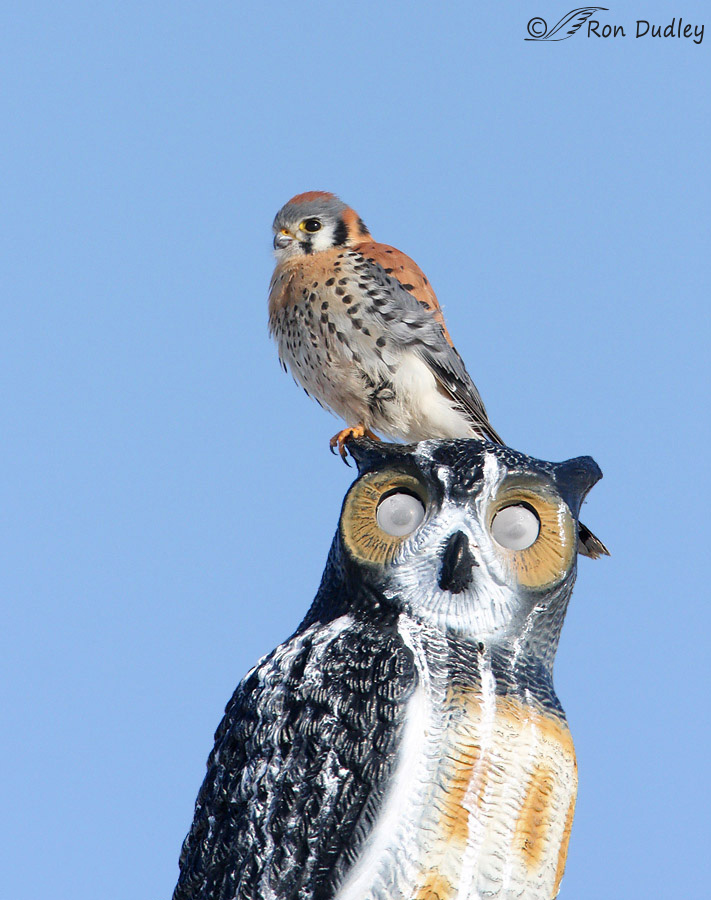
Thankfully birds are resourceful and most any elevated hunting perch will do – it doesn’t have to be a tree. There aren’t any utility poles to speak of on the ‘refuge’ but there is a metal tower used for a weather station topped with two plastic owls meant to keep birds from perching on the sensitive equipment.
But American Kestrels are nothing if they aren’t cheeky so those plastic owls have become one of their favorite hunting perches.
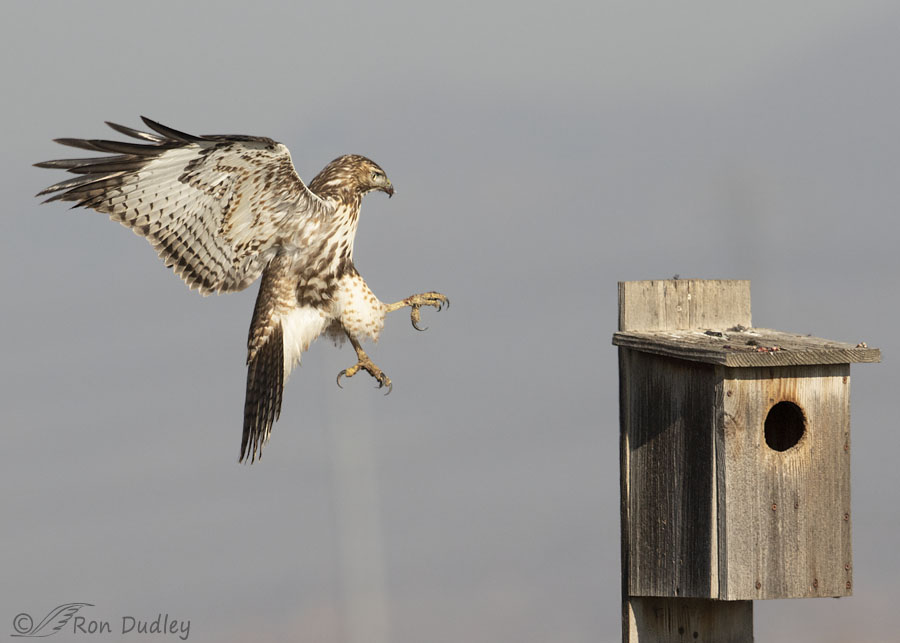
There are several kestrel boxes on the refuge that are ideal elevated hunting perches for a variety of species including this Red-tailed Hawk. I posted this photo a few days ago, taken as the hawk returned to the perch after an unsuccessful hunting foray.
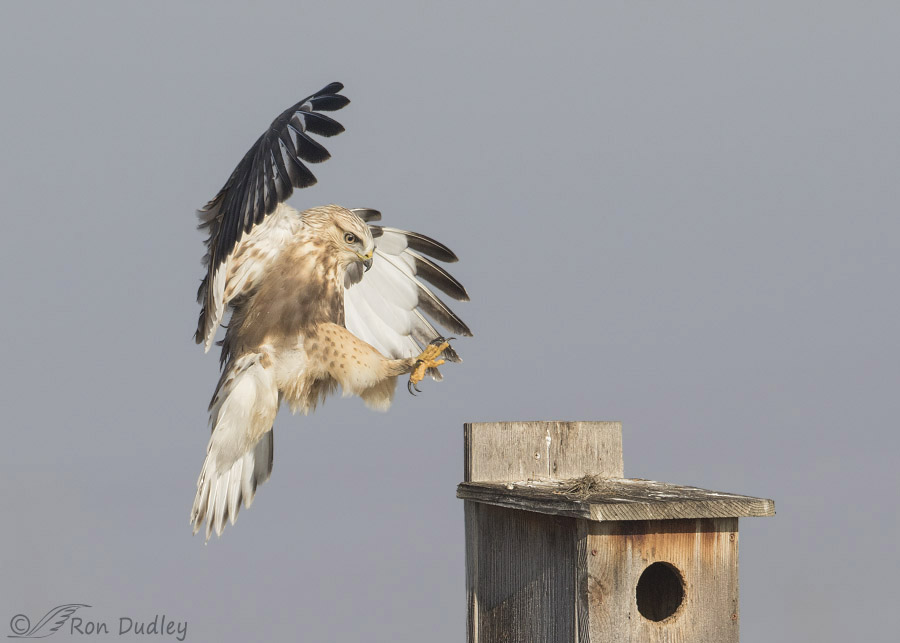
Here a Rough-legged Hawk is returning to the same kestrel box for the same reason. Thankfully these kestrel boxes are well designed and last for years but there are very few of them on the vast refuge.
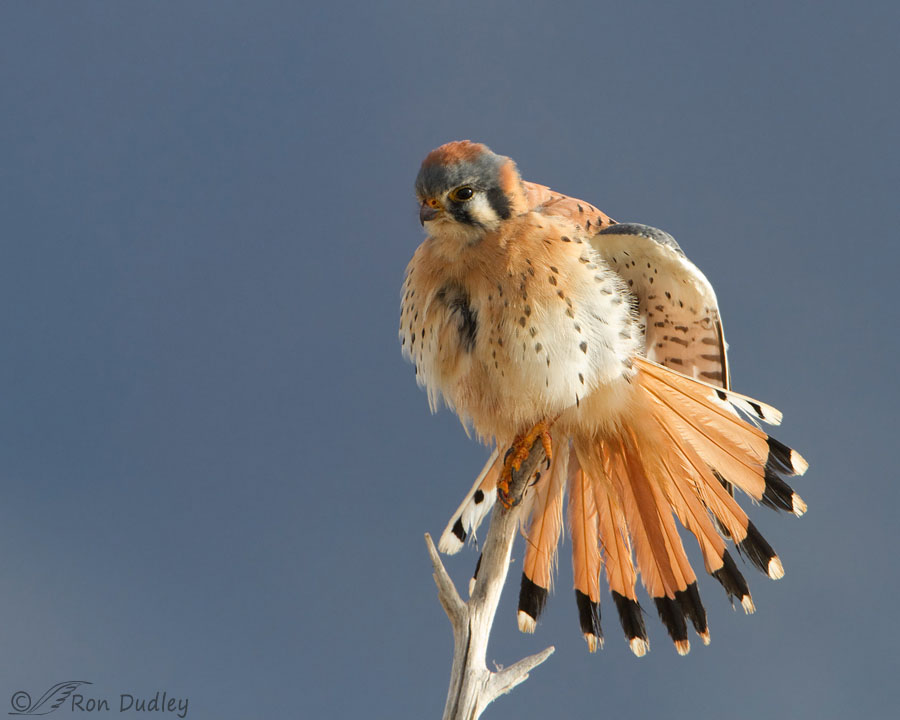
This small snag (dead tree) on the edge of Unit I was a favorite kestrel perch for the first several years after I began photographing birds.
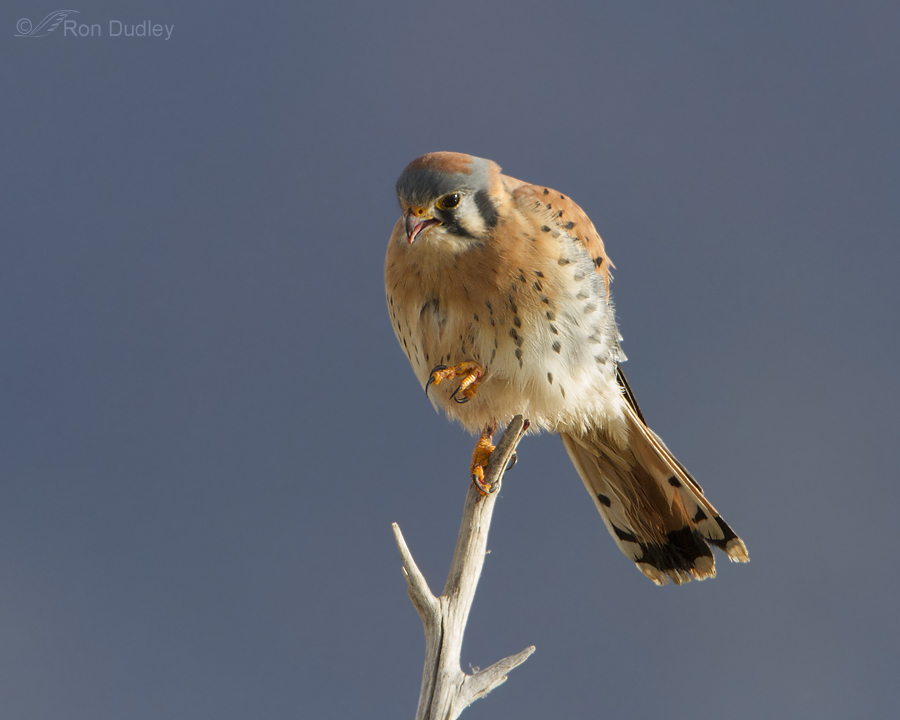
I’ve photographed many dozens of kestrels on it but it was small and very old and eventually it toppled over (or was deliberately pushed over) so it’s been gone for years now.
This male kestrel had been cleaning his toes. I don’t think they tasted very good.
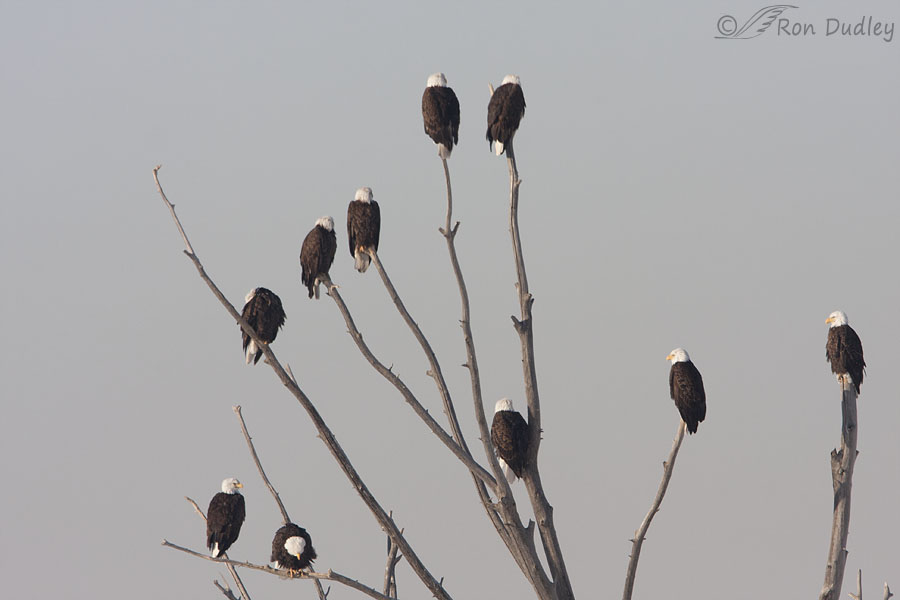
This is part of what used to be called the ‘eagle tree’ at Farmington. By the time this photo was taken most of the beloved but dead old tree had fallen down but I’d still often see a dozen or more Bald Eagles roosting on what was left standing. Old timers at Farmington have photos of 30-40 eagles in the eagle tree. Or more.
But the eagle tree is entirely gone now, a victim of the ravages of wind and time. Trees aren’t forever.
And they’re not being replaced. Just in the last year many additional trees at Farmington have met their demise, particularly at the north end of the refuge near where the refuge manager’s old office used to be, but elsewhere too. Farmington’s infamous winds have seen to that.
I’m hoping that in the near future the ‘powers that be’ will see fit to replace some of the lost trees with native species. If this trend continues FBWMA will soon be as flat and featureless as a pancake, with little practical appeal for raptors and many other birds and little aesthetic appeal for human visitors.
Ron


I thought I would make a donation, perhaps with a note/suggestion to direct it to build raptor perches. So, I went to the FBWMA website:
https://greatsaltlakenaturecenter.org/homepage.html
and clicked on the support (donate) website which took me to:
http://www.uwin.org/
which took me to a wristwatch review site.
A waste of time; the website appears not maintained for many years.
Tried the Eccles center:
https://wildlife.utah.gov/discover/eccles-education-center.html
No provision for donations there, either.
Lyle, that first website you tried is for the old Nature Center, before the new Eccles Wildlife Center was built (on the same location). I’m surprised they haven’t taken that site down. It should have been.
Perhaps someone could coordinate with the refuge and organize a gofundme to put up a dozen more nest box perches??? I’d contribute!
Interesting idea, Art. I’m not sure but I believe HawkWatch International installs and maintains the kestrel boxes at Farmington. It may be that they’re already placed and spaced in the most optimal locations. I just don’t know for sure.
Personally I think it’s really more native trees and shrubs that are needed out there. But what do I know…
Well that may be true but a citizen effort to provide perches could more quickly put up usable “trees” that are useful to raptors but manmade than grown. Just like at home…. if I plant a 4’ evergreen here it will be after my remaining lifetime when I or a raptor would find it useful. 🙂
Me, too!
One of the few instances where the human factor isn’t the main cause of habitat decline … except that humans could do something about replacing those lost trees. So I hope maybe some others in your area will also put a bug in the right ear(s) — and maybe step on a toe or two — to get some movement on this. If the settlers could successfully plant trees 100+ years ago in the face of fierce winds, so can today’s inhabitants, especially with a much improved understanding of natural landscapes.
Good point, Chris. The town of Farmington which is right next door is teeming with trees, native and otherwise. And some native shrubs and bushes would be a welcome addition too.
Ron,
I have always loved and been fascinated by birds but have been late to this bird photography game only photographing birds for the last several years. I long for the legendary days of FB that I have heard so much about but, alas, it is what it is. I did love the day in February a couple of years ago when I counted over 100 Bald Eagles from the road. If not for your blog I would have never know that kind of birding opportunity existed anywhere near me!
Love your stuff,
Stephen
Thanks very much, Stephen. Yes, FBWMA ‘is what it is’ but that doesn’t mean it has to stay as it is.
Can you poke Billy Fenimore? There seems to be a partnership between the bay and the Nature Conservancy. Perhaps a good scout project? Local Audubon project? Seems a good thing to put a bug in someones ear.
Ha, I already had it in my mind to give my friend Billy a little poke. 🙂
This post makes me mad — and sad — the same thing is happening around here with ugly-one-giant-house-built-on-top-of-another developments right next to protected (finally!) wetlands and natural spaces. I worry not only because of the space encroachment, but also because of the inevitable pollution and contamination of the area from automobiles, yard runoff, trash, etc.
Your eagle tree gets me every time. I have yet to see even one Bald Eagle in the wild and you have a full basketball game just in that tree! 😍
“you have a full basketball game just in that tree!”
Marty, reading your comment took me from the despair of your opening paragraph to a literal LOL with your final sentence. Thanks for that.
❤️
Incredible series Ron! Thanks for sharing!
Thanks, Charlotte.
Oh Ron.
My tree hugging bird loving self finds this a beautiful but also dreadfully sad post.
I do hope that more trees/perches can be planted and/or built. In the fullness of time I am hoping for an eco-funeral and feeding a tree (and thereby providing bird perches) sounds pretty damn good to me.
And of course I smiled at the kestrel on the plastic owl – and was awed at the beautiful spread of tail feathers in a later shot.
EC, feeding a tree, or multiple trees, in the way you describe sounds to me like the ideal legacy.
But I’m beginning to worry about your sleeping schedule – your comments seem to keep coming in earlier and earlier. Folks need sleep ya know – if this trend continues I worry that you’ll be feeding trees sooner than you intend to… 🙂
Thanks Ron. And yes, I am dead tired – but unable to sleep (except in snatches) at the moment.
I hope to nap later.
Sweet dreams during your nap.
Tree planting sounds like a great projects for your local Audubon Society—assuming the WMA manager is agreeable. Your closest group there is likely the Great Salt Lake Audubon Society. Until these tree are large enough to be of value to raptors, perhaps you could locate a scout looking for an Eagle Scout project. Many of these scout projects involve wildlife habitat enhancements—e.g., building and installing nest boxes for waterfowl or owls. In my experience, these projects involve developing a formal written plan (that meets the approval of the scout leader and refuge manager in this case), securing funds or donations of materials (like tall metal or treated wooden posts), and rounding up volunteers (typically his/her fellow scouts) to complete the project. This project could even include determining the best tree species to be planted, enlisting the assistance of the local Audubon group, and overseeing any necessary fund-raising efforts. The nearby student chapter of The Wildlife Society at Utah State University could be another possibility to either assist the scout or head up the project themselves. These student chapters are often looking for worthwhile wildlife projects.
Some excellent suggestions, Ron
I hesitate to step on the toes of the refuge manager. He’s one of the good guys and I’m sure he knows the score but he has a lot on his plate and these days in particular the politics of managing a place like FBWMA are incredibly complex and increasingly aggravating.
My intent here is to plant a seed – not of a tree but of an idea.
If you’d like to plant that seed with the student chapter at USU, I just found this older (2017-2018) link for their officers and faculty advisors: https://qcnr.usu.edu/undergraduates/organizations/tws/officers. The same two professors are likely still the advisors.
BTW, have you settled on a replacement for you Canon 7DM2? Would love to hear your thoughts on this subject. So, please keep us posted via your blog.
Nope, no decision yet on the replacement other than to just sit on it for a while longer.
I almost sprung for the R5 but two things prevented it – the loss of the extra reach of a cropped frame camera and the low battery life because of the electronic viewfinder. Hell, it isn’t unusual for me to sit on a bird for a half hour or more waiting for it to take off. You can imagine the battery drain that would be for an EVF. I’d have to have a pocket full of batteries and the bird would undoubtedly take off while I was switching out batteries anyway… 🙂
We’ll see what the R7 looks like when it comes out next year.
Wouldn’t cropping a 45 MP image give you roughly the same “reach” & image quality as you’re getting with a 1.6X crop factor on the 7DM2? A battery back would double battery life, but still might not be enough. I hadn’t heard that a R7 was on the horizon in 2021; so, thanks for the heads up.
The more than twice as large sensor of the R5 would make up for part of what I’d lose but not all of it, I don’t think. But I was prepared to purchase the R5 anyway (actually had one ready for me to pick up locally) until I thought carefully about that battery problem in combination with my shooting style. The battery issue is the biggest stumbling block for me, even with the battery pack which I definitely would have purchased – in part to make that dinky camera feel larger and more comfortable in my hands.
In terms of resolving detail on a subject at a given distance from the camera, there’s no difference between using a smaller sensor and cropping a larger sensor, as long as you’re using the same lens and the pixel size is the same for both sensors and the anti-aliasing screens are similar. According to the specs, your camera and the R5 do have very similar pixel sizes. I have no info on the anti-aliasing screens. There can be important differences in dynamic range, of course, but that’s a separate issue.
I apologize for my post regarding cropping. That wasn’t helpful at all.
There’s no reason at all for you to apologize, Phil. I actually DID find it helpful and I appreciate you weighing in.
I had kind of arrived at a similar conclusion and was prepared to purchase the R5 until I thought more carefully about the battery issue in combination with my shooting style.
Sad that the old perches are going and not being replaced. Wonder why no natural regeneration in the area? Are conditions just not right as with the Cottonwoods in area of MT (flooding pretty much needed) or something else?
Judy, I’m not sure why they don’t regenerate on their own but they rarely seem to. I suspect many of them were planted by early settlers.
.
That could be……
Great photos all – especially the Kestrel with the spread tail feathers. It really does look like the powers to be need to start planting trees there. Definitely not going to see many eagles there without taller trees. Urban progress never seems to slow down as our population continues to grow. Here in Prescott we continue to lose prime open lands as more and more people move here especially those escaping California.
Everett, the eagles seem to adapt reasonably well without nearby roosting perches. They spend a lot of time far out on the ice. I think other raptor species adapt less well to the lack of hunting perches.